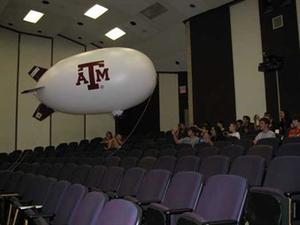BlimpsTexas A&M launches a blimp program
Texas A&M is launching a new airship program to develop lighter-than-air (LTA) blimps; LTA systems generate lift force by using sufficient volume of a lighter-than-air gas, such as helium; heavier-than-air (HTA) systems, on the other hand, generate lift by a relative motion between the wings or rotor blades and ambient air; airships can contribute to a number of missions including disaster response, homeland security, and communications relay

The student program's initial exercise in the blimp program // Source: tamu.edu
A new airship activity has been launched this summer in the Aerospace Engineering department at Texas A&M University. Dr. Rajkumar Pant is collaborating with Dr. Sharath Girimaji of the Aerospace Engineering Department and Dr. Christian Bruccoleri of the Space Engineering Research Center (SERC) to kick-start research and development activities related to Lighter-Than-Air (LTA) systems at Texas A&M.
LTA systems principally generate lift force by using sufficient volume of a lighter-than-air gas, such as helium. Heavier-Than-Air (HTA) systems, on the other hand, generate lift by a relative motion between the wings or rotor blades and ambient air, consuming a large amount of fuel.
Dr. Pant is an Associate Professor of Aerospace Engineering at the Indian Institute of Technology Bombay where he has set up a laboratory in which student teams design, build and fly airships from scratch. This summer, TAMU Aerospace Engineering students are becoming familiar with the airship operation controls with some indoor flying at the SERC’s facility in the University Services Building.
The pictured aerostat, measuring 5 feet by 11 feet, will next carry a light payload consisting of a camera, wireless transmitter, and a smart phone for a simulation of an “operational” mission. Larger airships with real payloads can contribute to a number of missions including disaster response, homeland security, and communications relay, to name a few. Dr. Girimaji plans to build a student team program at TAMU to contribute to both design curricula on the academic side and research into innovative payloads and high altitude airship operations.
Thirteen high school students participating in the Youth Adventure Program (YAP) were able to catch a first glance of the TAMU aerostat at a demonstration in Zachry on 21 July. YAP is a series of 1-week courses designed to encourage career exploration in fields of interest to gifted and talented students. These students spent the day in the Aerospace Engineering Department learning more about the field and designing and building glider aircraft.
To watch the airship in action, visit here and here.
